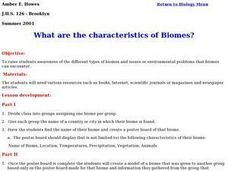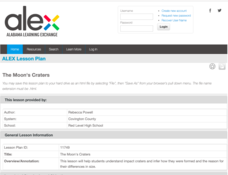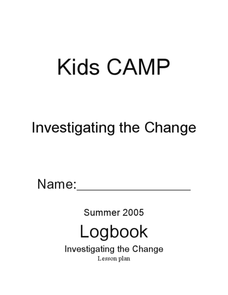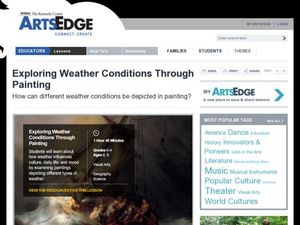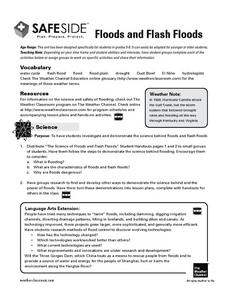Curated OER
Changes in the Atmosphere or Hydrosphere
In this atmosphere and hydrosphere worksheet, learners work on assigned topic which are either categorized as human activity or natural activity which impact the atmosphere and the hydrosphere. Students work in groups and answer...
Curated OER
Science Unit Lesson Five
Sixth graders review how and which plants operate in terrariums. In groups, they follow instructions to make their own terrarium and place different types of plants in it. To end the lesson, they review the steps in the water cycle and...
Curated OER
Working With Electronic Topography Maps
Junior geologists examine topographic maps online and learn how to read them. they answer seven associated follow-up questions. This lesson plan is only a general outline and does not provide the details or the websites that you...
Curated OER
Science Puzzlers, Twisters, and Teasers: The History of Life on Earth
A somewhat amusing assignment, this worksheet lists statements that an ancient organism may have made and asks learners to determine what geologic era that each may have lived in. It uses witty word puzzles and fill-in-the-blank-style...
Curated OER
What Color is Your Colony?
Students conduct an experiment to change the color of E. coli bacteria using genetic engineering. They work in small groups to add a plasmid containing a gene for red pigment to the bacteria and culture the bacteria to see if it ...
Curated OER
What Are the Characteristics of Biomes?
Students working in groups study different types of biomes and the issues or environmental problems that can affect them. They design a poster board that displays the characteristics of their biome. They make a model of the biome that...
Curated OER
What Can We Lose? What Do We Lose as we Gain Force With A Lever?
Third graders view a demonstration of a teeter totter as a basis for assessing pre-knowledge of a lever. They create a KwL chart. Students work in small groups to conduct a variety of experiments. The first requires students to tie books...
Curated OER
What Do We Mean by "Living Things"?
Students discuss the characteristics of life. In this living things instructional activity students complete a lab while working in groups. Students examine different organisms and create a poster to present to the class.
Curated OER
Life Science Investigation
Young scholars work to investigate an aspect of life science of interest to them from a list. Using the Internet, they research information and take notes on what to include in their presentation. They share their findings with the...
Alabama Learning Exchange
What Burns When a Candle Burns? an Introduction to Using the Scientific Method
Middle schoolers use the scientific method to discover the role of a candle's wick and how radiation allows candle wax to change from solid to liquid to gas. They work in small groups to use the steps of the scientific method approach in...
Curated OER
How Small is Small?
Students view the video "The Invisible World" and discuss different types of microscopes and what can be seen with each type. They work in pairs to view several objects with a microscope.
Curated OER
What's the Weather Like in.....??
In this weather vocabulary worksheet, 2nd graders, working with a partner, read and discuss what the weather is like in six specific foreign cities. Students carry on a conversation with each other concerning the weather in six different...
Curated OER
What is Temperature and How Is It Measured?
Students complete activities to measure temperature. In this temperature lesson, students read Geoffrey Groundhog Predicts the Weather and make a KWL chart about predicting weather. Students discuss folklore about temperature and learn...
Curated OER
How Do You Light Up Your World?
A tremendous presentation on the properties of light. Young scientists are treated to slides which share a lot of fascinating information about light. This impressive PowerPoint is filled with great photos, graphics, and discussion...
Curated OER
Traveling Through the Digestive System
Second graders learn about how the food is broken down in our bodies and the job of each body part involved in our digestive system. The utilize the CD ROM game, "Body Works." This wonderful game takes pupils through the human body's...
Curated OER
Investigating the Change
Sugar crystal growth is observed as an example of physical change and cabbage juice pH indicator is used to demonstrate chemical change. The crystal growth is tracked over five days. The cabbage juice experiment is involved and can also...
Curated OER
Exploring Weather Conditions Through Painting
Your advanced class will paint a picture of a particular weather condition. In this painting lesson young scholars describe elements of art in pieces of artwork. They analyze the weather and seasons in the artwork. The students use...
Curated OER
Changing Planet: Permafrost Gas Leak
Pair earth scientists up to use an amazing online arctic portal mapping tool and Google Earth to analyze permafrost changes. They compare changes to data on atmospheric concentrations of methane to see if there is a correlation. Then...
Curated OER
Seein' Double, Seein' Double
By using the Internet, hands-on activities, video, and cooperative learning, pupils look into the conditions in which light casts shadows on objects. The lesson includes fabulous hands-on activities, art projects, worksheets, and reource...
Curated OER
Floods and Flash Floods
Junior geologists, hydrologists, or meteorologists simulate what happens during the flooding of a river and demonstrate factors that contribute to flash flooding. This outstanding resource provides a vocabulary list, online resources,...
Curated OER
Motion, Forces, Energy and Electricity
What a wonderful way to explore motion and forces! Learners design a catapult, after watching a video and discussing types of catapults. This is a comprehensive and complete lesson with links to supplementary resources.
Curated OER
Real Life Chemistry (for the Business World)
In this real life chemistry worksheet, students are given 12 problems to solve by converting from one unit to another. Students are given conversion factors to find their answers including finding the number of moles and molecules.
Curated OER
Power
If you need to teach about power, this is an outstanding educational resource! It provides definitions of work and power, and gives examples to help junior physicists apply the information. The format is neat and the graphics are...
Safe Drinking Water Foundation
Ask an Engineer
A wrap-up to the unit, young environmentalists discuss and write about the difference in perspectives of a water keeper and water treatment engineer.





